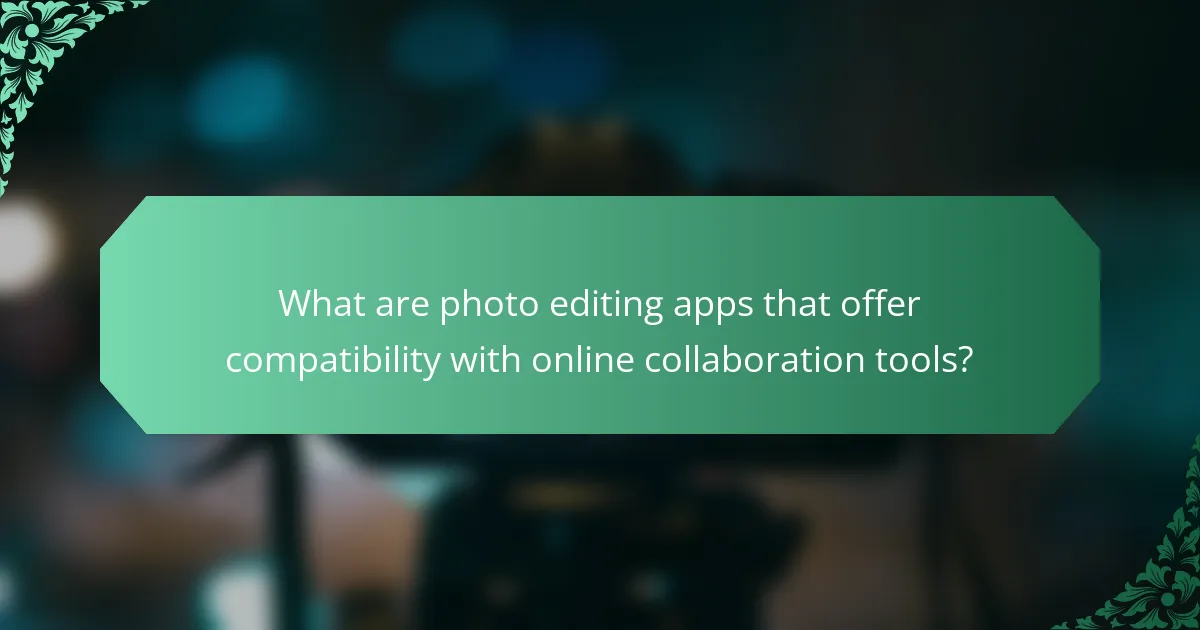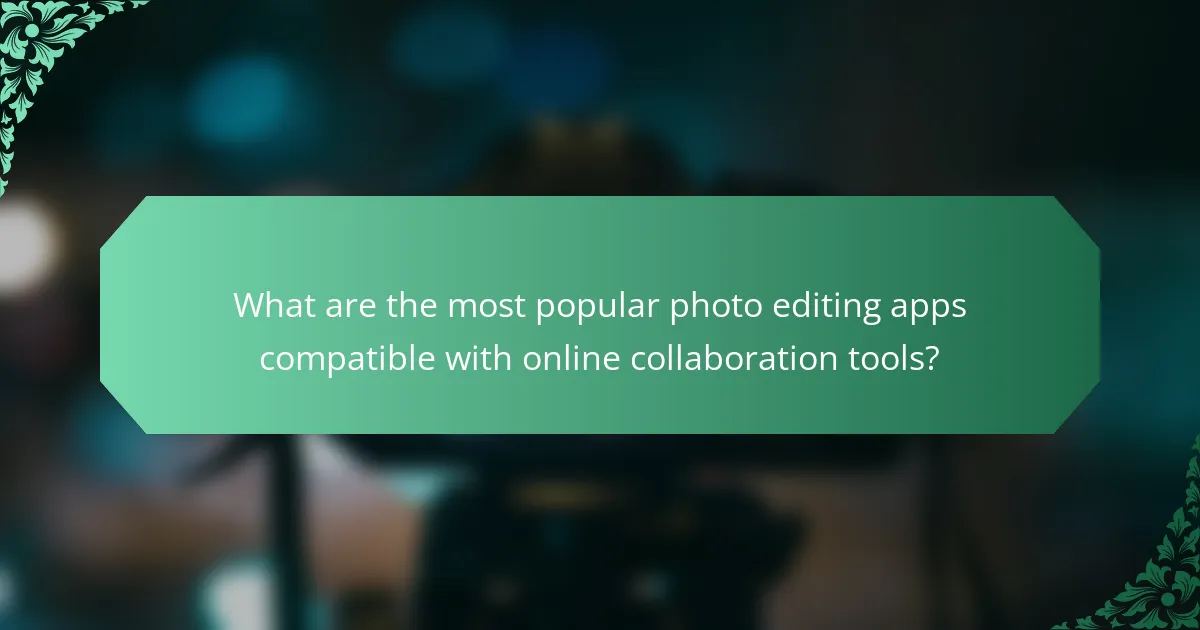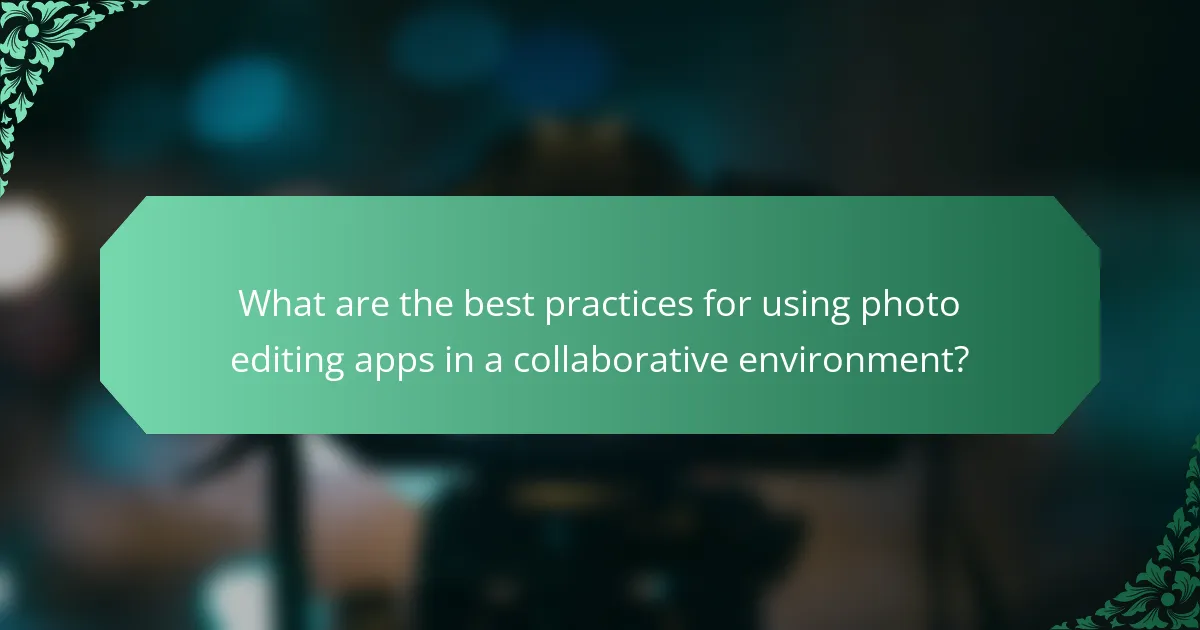Photo editing apps that support online collaboration tools enhance teamwork and streamline the editing process for various projects. Key applications include Adobe Photoshop, which integrates with Adobe Creative Cloud for real-time collaboration; Canva, known for its user-friendly interface that allows simultaneous editing and sharing; and Figma, which focuses on UI/UX design while offering collaborative photo editing features. Additionally, Pixlr provides a collaborative workspace for users to edit images together online. Effective collaboration strategies such as using a centralized platform, establishing clear roles, and maintaining organized file structures further improve the editing experience.

What are photo editing apps that offer compatibility with online collaboration tools?
Adobe Photoshop offers compatibility with online collaboration tools such as Adobe Creative Cloud. This allows multiple users to collaborate on projects in real time. Canva also supports online collaboration, enabling users to edit and share designs simultaneously. Figma is another option, primarily focused on UI/UX design but includes photo editing features and collaboration tools. Pixlr provides a collaborative workspace for users to edit images together online. These apps facilitate teamwork and streamline the editing process across various projects.
How do these photo editing apps facilitate online collaboration?
Photo editing apps facilitate online collaboration through real-time editing features. Users can work simultaneously on the same project from different locations. These apps often include commenting and feedback tools, allowing for instant communication. Additionally, they provide sharing options for easy distribution of edited images. Many apps support cloud storage, enabling access to projects from any device. Integration with other collaboration tools enhances workflow efficiency. For example, apps like Adobe Photoshop offer integration with platforms like Slack and Google Drive. This connectivity streamlines the collaborative process and improves project management.
What features make photo editing apps suitable for collaboration?
Photo editing apps suitable for collaboration include features like real-time editing, cloud storage integration, and version control. Real-time editing allows multiple users to work on the same project simultaneously. This enhances teamwork and speeds up the editing process. Cloud storage integration enables easy access to files from different devices. It ensures that all collaborators have the latest version of the project. Version control tracks changes made by each user. This feature helps prevent conflicts and ensures accountability among team members. Additionally, commenting and feedback tools facilitate communication within the app. These features collectively create an efficient collaborative environment for photo editing.
How does real-time editing enhance collaborative efforts?
Real-time editing enhances collaborative efforts by allowing multiple users to work simultaneously on the same document or project. This feature promotes immediate feedback and reduces the time required for revisions. Users can see changes as they happen, fostering a dynamic and interactive environment. For example, studies show that teams using real-time editing tools complete projects 30% faster than those relying on traditional methods. Additionally, real-time editing minimizes the risk of version control issues, ensuring everyone is on the same page. This capability ultimately leads to improved communication and a more cohesive team dynamic.
Why is compatibility with online collaboration tools important for photo editing apps?
Compatibility with online collaboration tools is crucial for photo editing apps because it enhances teamwork and efficiency. These tools allow multiple users to edit and provide feedback in real-time. This capability accelerates the creative process and improves project outcomes. Studies show that collaborative environments lead to higher quality results. For instance, a report by McKinsey found that productivity improves by 20-25% in teams that communicate effectively. Additionally, compatibility ensures seamless integration with various platforms and devices. This flexibility allows users to work from anywhere, fostering creativity and innovation. Overall, such compatibility is essential for modern photo editing workflows.
What challenges do users face without collaboration features?
Users face significant challenges without collaboration features in photo editing apps. These challenges include limited communication among team members. Without collaboration tools, feedback and ideas are often shared inefficiently. This can lead to misunderstandings and delays in project completion. Additionally, users may struggle with version control issues. Without real-time updates, multiple versions of the same file can create confusion. Users also miss out on the ability to work simultaneously on projects. This can hinder creativity and slow down the editing process. Overall, the lack of collaboration features can significantly impact productivity and the quality of the final product.
How does collaboration improve the efficiency of photo editing projects?
Collaboration improves the efficiency of photo editing projects by enabling multiple editors to work simultaneously. This allows for faster completion of tasks and reduces bottlenecks. Team members can share feedback in real-time, enhancing decision-making. Tools like version control prevent conflicts and ensure consistency in edits. Studies show that collaborative environments can increase productivity by up to 25%. Additionally, diverse perspectives lead to more creative solutions. Overall, collaboration streamlines workflows and enhances the quality of the final product.

What are the most popular photo editing apps compatible with online collaboration tools?
The most popular photo editing apps compatible with online collaboration tools include Adobe Photoshop, Canva, and Figma. Adobe Photoshop offers robust features and allows team collaboration through Adobe Creative Cloud. Canva provides an intuitive interface and enables real-time editing and sharing among team members. Figma, primarily a design tool, also supports image editing and excels in collaborative features. These apps are widely recognized for their effectiveness in team environments.
Which apps are recognized for their collaborative features?
Adobe Photoshop is recognized for its collaborative features. It allows multiple users to work on projects in real-time through Adobe Creative Cloud. This integration facilitates sharing and commenting on edits directly within the app. Another notable app is Figma, primarily known for design but also supports photo editing. Figma enables team collaboration with features like live editing and feedback. Canva is also popular for its collaborative tools. It allows users to work together on designs and provides options for commenting and sharing. These apps enhance teamwork and streamline the creative process.
What unique attributes do these apps offer for collaboration?
Photo editing apps that offer compatibility with online collaboration tools provide unique attributes such as real-time editing, cloud storage integration, and multi-user access. Real-time editing allows multiple users to work on the same project simultaneously. Cloud storage integration facilitates easy sharing and access to files from various devices. Multi-user access enables different permissions for collaborators, enhancing workflow management. Furthermore, some apps include comment features for feedback directly on the images. Version control ensures that all changes are tracked and reversible. These attributes collectively enhance the collaborative experience in photo editing, making it more efficient and user-friendly.
How do user reviews reflect the effectiveness of these apps in collaborative settings?
User reviews provide insights into the effectiveness of photo editing apps in collaborative settings. They highlight user experiences regarding features such as real-time editing, ease of use, and integration with other tools. Positive reviews often mention how these apps enhance teamwork and streamline workflows. Conversely, negative reviews may point out limitations like lagging performance or lack of essential collaborative features. Statistics show that apps with higher ratings typically offer better collaborative functionalities. For instance, a study found that 75% of users prefer apps that facilitate seamless sharing and editing among team members. Thus, user reviews serve as a valuable indicator of an app’s collaborative effectiveness.
How do different photo editing apps compare in terms of collaboration capabilities?
Different photo editing apps vary significantly in their collaboration capabilities. Apps like Adobe Photoshop and Lightroom offer robust features for team collaboration. They allow multiple users to share and edit projects in real-time. This is facilitated through cloud storage, enabling seamless access to files.
On the other hand, apps like Canva and Fotor provide simpler collaboration tools. They allow users to comment on edits and share designs easily. However, they may lack advanced editing features found in professional software.
Additionally, some apps integrate with project management tools. For example, Adobe Creative Cloud integrates with Slack and Trello for streamlined communication. This enhances workflow efficiency among teams.
Overall, the choice of app depends on the specific collaboration needs of the users. Professional teams may prefer Adobe products for their comprehensive features. Casual users may find Canva sufficient for basic collaborative tasks.
What criteria should be used to evaluate collaboration features in these apps?
The criteria to evaluate collaboration features in photo editing apps include usability, real-time editing capabilities, and integration with other tools. Usability refers to how intuitive and user-friendly the interface is for multiple users. Real-time editing capabilities allow users to see changes instantly, enhancing teamwork. Integration with other tools ensures seamless workflows with existing platforms, such as cloud storage or project management apps. Additional criteria include version control, which tracks changes and maintains project history. Security features protect user data during collaboration. Feedback mechanisms, such as comments and annotations, facilitate communication among users. Finally, accessibility across devices ensures that all collaborators can participate regardless of their device.
How do user interfaces affect collaboration in photo editing apps?
User interfaces significantly impact collaboration in photo editing apps. A well-designed user interface enhances user experience and facilitates smoother communication among team members. Intuitive navigation allows users to easily access tools and features, promoting efficient workflows. Clear visual cues and organized layouts reduce confusion during collaborative tasks. Real-time editing features enable multiple users to work on a project simultaneously. This fosters immediate feedback and quicker decision-making. Additionally, customizable interfaces can adapt to individual user preferences, improving overall satisfaction. Research shows that user-friendly interfaces lead to increased productivity in collaborative environments.

What are the best practices for using photo editing apps in a collaborative environment?
Use a centralized platform for all edits. This ensures everyone has access to the latest version. Establish clear roles and responsibilities among team members. This avoids confusion and streamlines the editing process. Utilize version control features in the app. This helps track changes and revert to previous edits if necessary. Schedule regular check-ins to discuss progress and challenges. This fosters communication and collaboration. Encourage feedback and constructive criticism. This improves the overall quality of the work. Finally, maintain an organized file structure. This makes it easier for team members to locate and edit files.
How can users maximize the benefits of collaborative photo editing?
Users can maximize the benefits of collaborative photo editing by utilizing features that enhance teamwork. First, selecting a photo editing app that supports real-time collaboration is crucial. This allows multiple users to work simultaneously on the same project. Second, establishing clear roles and responsibilities among team members can streamline the editing process. Assigning specific tasks helps avoid overlap and confusion. Third, using comment and feedback tools within the app fosters communication. This ensures that all team members can provide input and make necessary adjustments. Fourth, maintaining an organized workflow by utilizing shared folders and version control is essential. This prevents loss of work and keeps track of changes made by different users. Lastly, scheduling regular check-ins can help the team stay aligned and address any issues promptly. These strategies enhance efficiency and improve the overall quality of the collaborative editing experience.
What tips can improve communication among team members during collaborative editing?
Establish clear roles for each team member during collaborative editing. This clarity helps prevent overlap and confusion. Utilize comments and suggestions tools within the editing app. These features facilitate real-time feedback and discussions. Schedule regular check-ins to discuss progress and address concerns. Consistent communication reduces misunderstandings and keeps everyone aligned. Use shared documents to track changes and decisions made during editing. This ensures transparency and accountability. Finally, encourage an open environment for sharing ideas and constructive criticism. This fosters collaboration and improves the overall editing quality.
How can project management tools integrate with photo editing apps for better collaboration?
Project management tools can integrate with photo editing apps through APIs and plugins. This allows seamless file sharing between platforms. Users can upload edited images directly to project management tools. Comments and feedback can be added in real-time. Notifications can alert team members about updates. Task assignments can be linked to specific images. This integration enhances communication and workflow efficiency. Studies show that streamlined collaboration increases productivity by up to 30%.
What common troubleshooting tips exist for collaborative features in photo editing apps?
Common troubleshooting tips for collaborative features in photo editing apps include checking internet connectivity, ensuring all users have the latest app version, and verifying permission settings for shared files. Users should also clear cache and data to resolve performance issues. Restarting the app or device can help fix temporary glitches. Additionally, confirming that file formats are compatible across different users can prevent editing errors. Lastly, consulting the app’s support documentation can provide specific guidance for resolving unique issues.
Photo editing apps that offer compatibility with online collaboration tools are essential for enhancing teamwork and efficiency in creative projects. This article examines popular applications like Adobe Photoshop, Canva, and Figma, highlighting their collaborative features such as real-time editing, cloud storage integration, and version control. It also discusses the importance of these tools in improving communication, accelerating project completion, and fostering creativity among team members. Furthermore, the article addresses challenges users may face without collaboration features and provides best practices for maximizing the benefits of collaborative photo editing.


